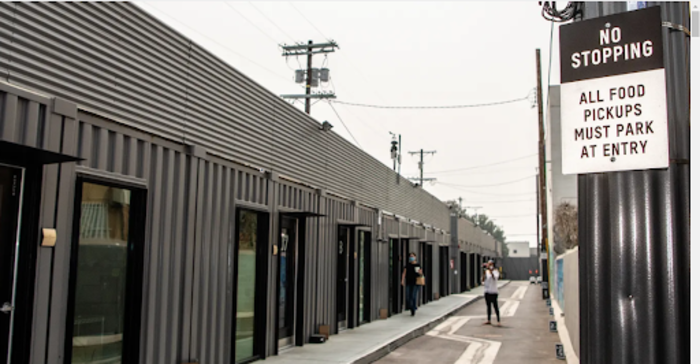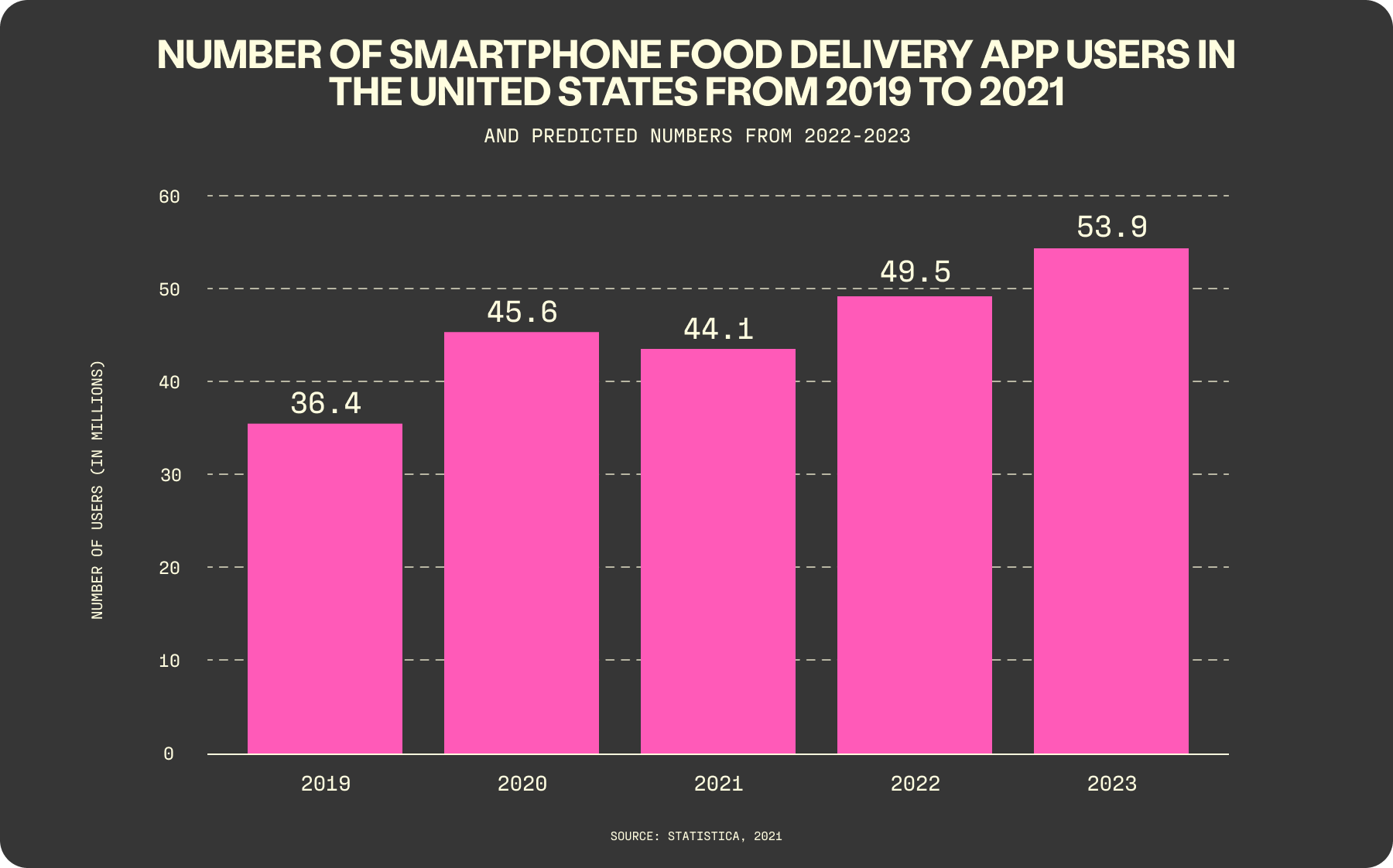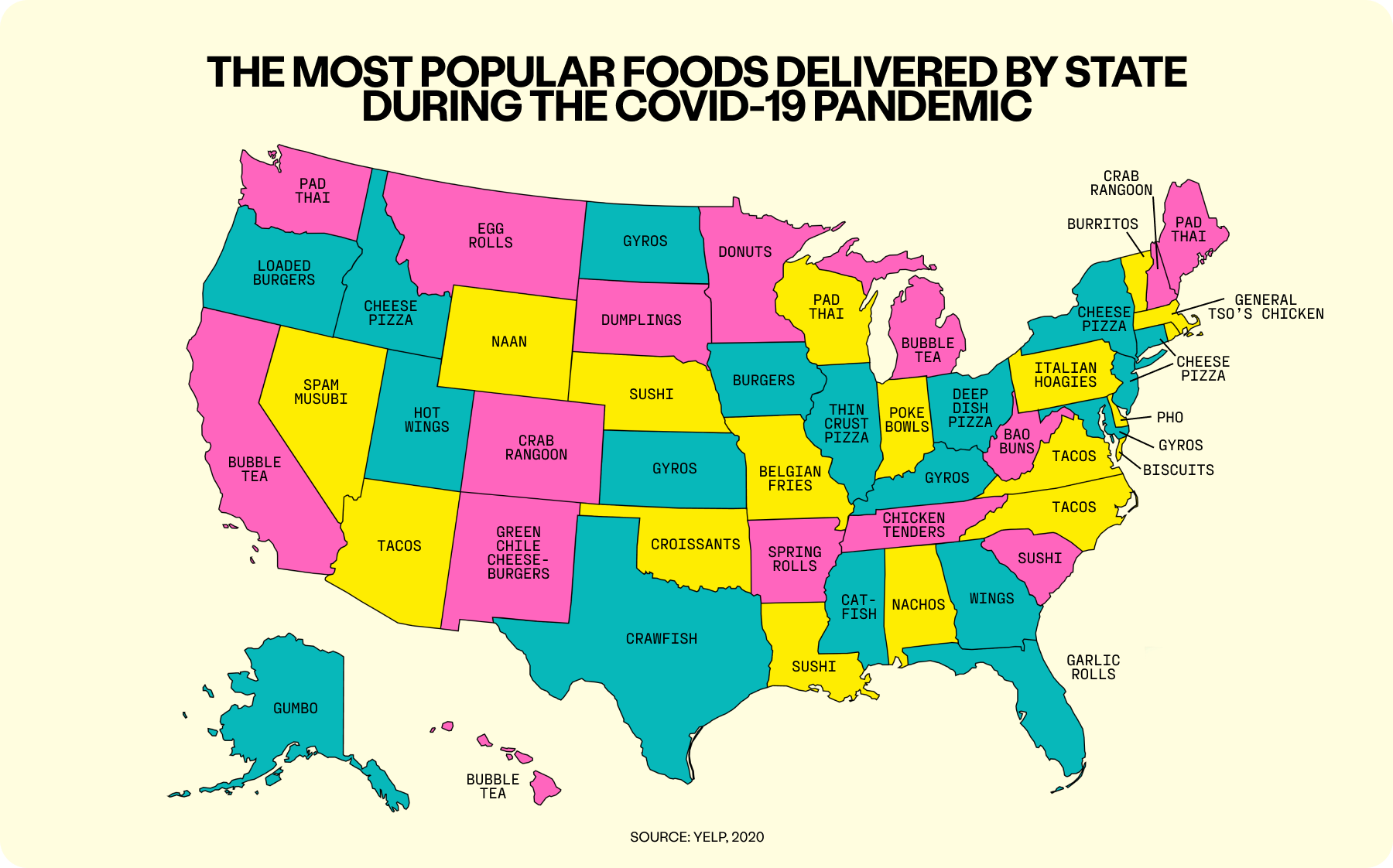Check Out This Guide:
Share
- Jump to:
It might seem strange to see a fast-casual Indian restaurant, vegan Thai food, and fried chicken spot show up right next to each other on Google Maps, all located in a very industrial area of town. What’s even more strange, is that if you were to walk by this area, you wouldn’t see the front entrance or even a sign for any of these restaurants. These are not actually restaurants with a storefront, dining area, and waitstaff, but delivery-only restaurant concepts.

Delivery-only restaurants are often low-key and indistinguishable from other industrial-style buildings in the area. This is a photo of small kitchens inside the Grand Food Depot in LA. Source: Eater & Mariah Tauger / Los Angeles Times via Getty Images, 2020
Delivery-only restaurants offer customers an innovative and convenient way to order and dine. Orders are placed and paid for online, and then the restaurant fulfills the order by delivering it to the customer through a third-party delivery company or service.
The COVID-19 pandemic took away the ability to dine-in restaurants essentially overnight in early 2020. In order to survive, restaurants had to pivot quickly to offer takeout and delivery food to continue bringing in revenue. Rent accounts for a huge part of a restaurant’s overhead costs, and with empty dining rooms, they were essentially paying for unused space.
Delivery-only restaurants were the logical response to coronavirus-induced lockdowns. In 2020, 25 percent of all online orders were for delivery. Online-based establishments were the dominating trend in 2020 and throughout 2021.
As we begin to shift back to pre-lockdown life, delivery habits still remain strong. According to Restolabs, by next year in 2022, 67 percent of restaurants would prefer to open a delivery-only restaurant over a dine-in as their next project. Pandemic or not, there are certainly many advantages to opening and operating a delivery-only restaurant.
What is a Delivery Only Restaurant?
As the name suggests, this type of restaurant only offers take-out food for delivery, and sometimes allows customers to pick up their orders. In this business model, there is no public-facing outlet, and the restaurant concept prepares food in a rented commercial or commissary kitchen. Once the food is prepared, a courier from a delivery service like Ubereats or DoorDash picks up the food and delivers it to the customer.
In this model, the menu is often simplified and streamlined, typically offering fewer menu items than a full-service restaurant establishment. Menu items must be able to travel well and stay fresh by the time they reach the customer. Many virtual restaurants focus on providing specific, popular menu items like chicken wings, pizza, burgers, burritos, and desserts. This is designed to accommodate hungry customers looking for specific foods, rather than a particular brand.
Delivery-only restaurants go by many names, including virtual kitchens, ghost kitchens, cloud kitchens, or dark kitchens.
How Does the Delivery Only Model Work?
The easiest way to understand a delivery-only restaurant is to imagine eliminating all customer-facing features. In this model, there is no need for FOH (front-of-house) staff or a dining room with tables and chairs. The focus of this model is consistent and quality food that is brought to the customer in a timely manner.
The delivery-only model is very much based online, depending on technology like streamlined online ordering, kitchen management systems, and third-party delivery services.
This model poses an excellent, less-risky way to experiment with new menu items and restaurant concepts. For example, say the owners of an existing Vietnamese restaurant have an idea for a fusion restaurant concept, but don’t have the flexibility to experiment with these dishes at their current restaurant. The owners also don’t have the funds to open up an entirely new restaurant location, and aren’t even sure if the fusion dishes they have in mind will be a hit. Opening up a delivery-only fusion concept allows for the owners to test drive an idea and commence operations quickly with low overhead and start-up costs.
This model also allows for restaurants to expand much more quickly than the traditional brick-and-mortar model. Imagine that that popular local sandwich shop is located at the far end of the town near a university. Students love ordering the quick, healthy, and affordable to-go food from here during lunchtime. The restaurant also receives delivery and to-go orders from the students attending the community college on the other side of town, which is about a 15-minute drive. However, by the time the sandwich is picked up or delivered, the bread is soggy and the lettuce is limp. By opening up a second location through a virtual/ghost kitchen on the other side of town, will improve the customer’s experience, the food quality, and bring in even more student customers. The same sandwich shop can also quickly expand to nearby cities, and throughout the state if desired.
Advantages of Delivery Only Restaurants
Operating a delivery-only restaurant offers many benefits compared to a traditional restaurant model. Restaurants with a traditional model struggle to stay in the green and on average, have profit margins between 3-5 percent. With the non-traditional delivery-only model, restaurants may find that they have more flexibility in how they operate, and more potential to increase revenue and profits.
1. Streamlined ordering process.
With this model, ordering on the phone and in-person is eliminated. This reduces the likelihood of delivery orders being heard and entered incorrectly. The ordering processing is always done via an online system or app, and entered directly by the customer. Orders received online are consolidated into a singular dashboard, streamlining orders for line cooks and chefs. Overall, delivery-only restaurants provide a simplified ordering process for both the customer and the restaurant.

The number of smartphone food delivery app users in the United States from 2019 to 2021 and predicted numbers from 2022-2023.
2. Dependable demand from third-party apps.
The delivery-only model is designed to be cohesive with third-party delivery services. With 45.6 million customers using food delivery apps in 2020, there is an ever-increasing demand for this service. Customers who are looking to have takeout food delivered desire convenience, consistency, and speed. Delivery-only restaurants are designed with all of this in mind.
3. Affordable way to build a brand.
Virtual kitchens will need to build their own website equipped with online ordering. With all orders completed online, this gives delivery-only restaurants an online presence. Even without a brick and mortar location, virtual kitchens can market themselves via third-party delivery platforms (like Postmates, DoorDash, UberEats, and GrubHub). Storefronts, signs, and billboards are expensive, but using the internet and social media to build a brand is often free.
4. Flexibility for innovation.
Some restaurants, especially ones with multiple locations and large, established restaurants, are slow to change and innovate. Delivery-only restaurants have much more room to experiment! Menu items can be easily and immediately be changed, added, or removed with online ordering systems. This is more difficult to do with printed menus or menu boards at traditional restaurant models. Data can show what menu items are most ordered, most profitable, and least popular. Using this information, virtual kitchens can quickly pivot to switch up the menu based on this.
With no set brick-and-mortar location, virtual kitchens can more easily switch to a different location if needed. Expansion is also more viable; it’s much more affordable to open up multiple delivery-only restaurants as opposed to traditional restaurants.
With no need to focus on the customer-facing features and front-of-house operations, this frees up time, energy, and resources to allocate for innovation.
5. Lower startup and operating costs.
Delivery-only restaurants do not need to sign a long-term lease on a restaurant space or buy a building. Operating out of a commercial kitchen significantly reduces the start-up and operating costs. Commercial kitchens offer flexible month-to-month leases, and even allow restaurants to pay by the hour. With no need for FOH (front-of-house) staff, this greatly reduces labor costs. Commercial kitchens are often already equipped with all needed supplies and appliances as well.
How to Start a Delivery Only Restaurant
Starting a delivery-only restaurant may prove to be much easier and affordable than opening a traditional restaurant. A virtual kitchen has a much lower barrier to entry than a brick-and-mortar establishment, yet the steps to opening one are very different.

The most popular foods delivered by state during the COVID-19 pandemic.
Plan the restaurant concept.
When customers are looking to order food to pick up or have delivered, they are not necessarily looking for a particular restaurant or brand, but are likely looking for a particular cuisine or menu item. Foods such as chicken wings, pizza, sushi, desserts, burgers, and noodles are typically popular delivery items. Beverages such as bubble milk tea and cold brew coffee have also become increasingly popular.
Do research to see what delivery options already exist in your area. If there are a few pizza places nearby, but absolutely no Asian food options, a sushi or stir-fry concept may be a great idea. Consider what demographics are underserved in your community, and plan a concept with unique offerings to your area.
Create a delivery-friendly menu.
All food will be delivered, so it is important to consider what menu items will say fresh and warm after being prepared, picked up by the delivery courier, and finally brought to the customer. You will need to consider that after the food is ready, it could take anywhere from 15-40 minutes to arrive at the customer’s doorstep.
Focus on easy-to-source ingredients that can be used in multiple dishes. Avoid complicated menu items that must be assembled upon delivery or separated into multiple to-go containers.
Develop the brand.
With no storefront to catch the eye of a potential customer walking or driving by, developing an online presence is key. This can start with a high-quality website that is search engine optimized. Claim your restaurant business on Google Maps to ensure that when a customer searches for “sushi near me” or “burgers place with delivery”, your restaurant pops up.
Social media platforms like Facebook, Instagram, Twitter, and Tik Tok are free to use, so this is a no-cost way to get your restaurant and brand in front of customer eyes.
Branding to-go packaging, bags, beverage containers, and even napkins are another way to develop your brand. This is an opportunity to make your brand stand out with a logo, color scheme, or even sustainable packaging.
RESTAURANT BRANDING IN 2022 (IDEAS + INSPIRATION)
Read the article here.

Virtual kitchen operator REEF partnered with DJ Khaled to open up a chicken concept, Another Wing. Source: REEF, 2021
Some delivery-only restaurants partner with celebrities or have celebrity faces to create hype around the business. This type of partnership automatically gives a brand more credibility and incentive for customers to check it out.
Choose your delivery service partners.
Partnering with third-party delivery platforms like UberEats, DoorDash, or Grubhub connects you with a wider audience. Having your restaurant listed on these platforms’ sites and apps is an easy way to gain exposure, especially as a new restaurant. Customers will never just happen to walk by your virtual kitchen, but they may just happen to scroll by your restaurant on a food delivery app.
Before selecting a delivery service partner, be sure that it services your area. Do market research to see if any particular partner is more popular in your community or city. Some cities and areas have local delivery services that are focused on certain niches; one of these may be a good fit as a partner. Some delivery services are also consistently faster than others; UberEats was found to be the fastest delivery service (out of all of the major players) with an average delivery time of 35 minutes and 31 seconds.
Ensure you have a seamless website.
As mentioned before, an online presence is key to developing your brand and marketing your restaurant. At the center of this is a seamless, attractive, and user-friendly website. Your website should of course be aesthetically pleasing and communicate your brand, but also functional for online ordering. According to Upserve, 90 percent of customers research a restaurant online before ordering from it, and 57 percent of those customers look at the restaurant’s website.
There are many different online ordering systems to choose from, and some are even geared towards virtual kitchens. Lunchbox helps the restaurant industry create branded websites, apps, and customized online ordering experiences.
Obtain all of your licenses and get kitchen space.
Obtaining licenses is often the most time-consuming process, so ensure that you give yourself plenty of time to complete this step. Before renting a commercial kitchen space, you will likely need to have all of your papers and licenses together. Your restaurant will need to be registered as an LLC, have liability insurance, and be inspected by your local health department. Employees and operators will need to have their ServSafe Food Handler Certification. Be prepared for setbacks and humps in the road, and allocate extra time and money to be prepared for anything that might arise.
To be able to sell food to customers, your restaurant must operate out of a licensed commercial kitchen. With the rapid increase of ghost kitchens during 2020, there have never been more options to choose from, especially in large cities. Commercial kitchens essentially operate as coworking spaces, but for those in the food industry like caterers, food trucks, farmer’s market businesses, and chefs. Commercial kitchens offer rental time per hour, week, and month, allowing you to select only the exact amount of time you need and saving your restaurant money.
Hire key members of the team.
Although you will not need to hire FOH staff for your delivery-only restaurant, you will need to hire line cooks, chefs, and a general manager. Be aware that employment levels in the food service sector have not returned to pre-pandemic levels. Many restaurants report that they are still struggling to hire back-of-house staff like line cooks and chefs.
Sync with POS and kitchen management software.
Consider syncing your restaurant’s POS (point-of-sale) system with the kitchen management software. Delivery-only restaurants are heavily reliant on streamlined technology, so syncing these systems can provide an enhanced degree of efficiency. An aggregator like Deliverect or Cuboh can be used to do so.
Develop a marketing strategy.
Even though you won’t have regular customers coming into your restaurant to dine at their favorite table, you can still encourage repeat customers. One way to do this is through offering a loyalty program. These progams encourage repeat customers and purchases. This is crucial because acquiring a new customer can be five to 25 times more expensive than retaining an existing one.
Be consistent on social media, and offer special deals for customers who follow you on these platforms. Try reposting photos that customers share of your food. Offer rewards, like a percentage off a meal, for customers that leave a review. Quality and consistent food encourages one of the best forms of free marketing - word of mouth!
Conclusion
Restaurants based on a traditional model often operate on low-profit margins, and after the economic devastation of the COVID-19 pandemic, many are still struggling to stay open. Although many customers are returning back to dining-in at establishments, online orders and food delivery still remain strong trends.
Delivery-only restaurant models have a considerably lower start-up and overhead costs, and a lower barrier to entry than traditional restaurant models. New restaurant concepts or niche menu items feel like a big risk to take in a time where the foodservice industry is unstable, but virtual kitchens allow for more flexibility and the ability to innovate.